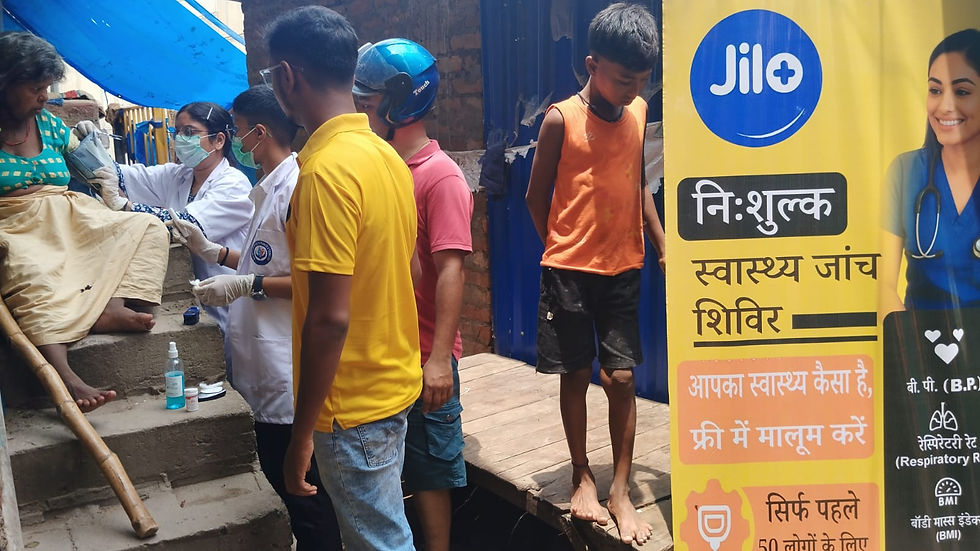The importance of Out of Hospital (OOH) care in making quality healthcare accessible and affordable for billions of Indians
- Suman Jha
- May 5, 2024
- 4 min read
Let’s begin this essay with a story we encountered during one of our visits to a drugstore in Phulwari Sharif, Patna, Bihar. The most crucial aspect of building a software business is shipping, creating a feedback-driven loop, and iterating, as all these activities generate essential information for progressing towards achieving early PMF. However, when building products and services involving multiple stakeholders, the most important aspect is constant and deep multi-stakeholder interactions. Because almost always, the initial layer of stakeholder interactions leads nowhere. These interactions keep you ahead of the market and competitors, as I learned from one of my mentors - Shashank Kumar, CEO of Dehaat. He engages in multi-stakeholder interactions every week.
During one of those visits to a drug store, the store manager complained to me about how the pharmacist was often absent during working hours (9 AM to 9 PM). The pharmacist explained the root cause: "Sir, log mujhe jante hain or store ka jo landlord hai unki Maa ko BP ka problem hai, to wo bula ke le jate hain check karwane ke liye to mai mana nahi kar pata hu" (Sir, everyone knows me, and the mother of the landlord of this store has a long-term illness, so they often call me for checkups). To be honest, I did not initially put much thought into this insight; however, when I was reading PORTEA’s DRHP, I realized this was nothing but an example of "Out of Hospital (OOH)" healthcare for Chronic Disease Care. It was another lightbulb moment because in countries like India where non-healthcare costs dominate healthcare costs due to supply constraints market, quality OOH care is a better and more affordable alternative (with a net cost comparison to in-hospital care being 50% lower).

Our strong conviction behind solving India’s healthcare problem is a firm realization that Most of the Healthcare continuum (Preventive, Primary, Recovery Protocol, Post-surgery etc) will be digital with the availability of Longitudinal Health Records, hence the major cost component would be treatment. However, in treatment as well, if we look closely, for most acute or short-term treatments, there is no issue with healthcare expenditure. The real financial strain arises in the case of long-term treatments because it allows Health Facilities to make a significant amount of money.
According to the F&S Report, 60% of the current in-hospital treatments could be done Out Of Hospital (OOH), including both short-term and long-term treatments. I think on a population level, Indian consumers can afford short-term in-hospital treatment; however, it is the long-term in-hospital treatment that is causing all the fundamental problems in our society. Here is the best part of OOH Care - 60% of the entire process can be digitized if Longitudinal Health Records are available to consumers/patients.
The table can give you a sense of how the accessibility and affordability of quality healthcare for billions of Indians is inevitable.

According to Frost & Sullivan estimates, the per day ICU cost at the hospital is double that of organized home care in both cases with and without ventilator. Non-clinical care can be provided at ₹15,000 - ₹18,000 per month in organized home care but can extend beyond ₹40,000 for the same care in hospitals. Now this difference is clear from the fact that when we are talking about OOH Care, there is no rent cost, which is one of the highest cost components; apart from this, every other expense that a hospital shares with each bed gets eliminated. Also, the price is affected by demand and supply as India is a supply-constrained market - the net prices are always higher because there is someone willing to pay a higher price. This cost benefit of home healthcare services is expected to remain a huge value proposition for market growth for organized home-based out-of-hospital healthcare.
The way India leapfrogged in communication, payment, and digital devices, the story of India’s Healthcare could experience something similar. To understand the net impact, we can make sense by thinking from this angle. Today, Health insurance is the only way to make treatment affordable for anyone in the world, including India. However, the unfortunate part about our country is that the voluntary penetration of Health Insurance is around 9%. As OOH care is 50% lower than in-patient care, the net premium to access quality healthcare through this medium would be much lower. And that would be the biggest net positive creator for our society.
This is something that will not demand fundamental behavioural changes in Indian consumers, as this is already happening (as explained in the above Story) even in India’s lower quintiles - Urban and Rural. However, we believe that trust and inclusion in Health Insurance (as there is an incentive for Insurance companies) will play a major role in making this a mass movement among Indian consumers. We believe in the next 10 years, all insurance companies will include OOH treatment in the package. And there will be a few large businesses in OOH care built especially from India’s lower quintiles. This is good news for Indian consumers and will help India make quality Healthcare accessible and affordable for everyone in the country.
Thanks for reading, if you find this interesting, we are building Jile Health, and would like to be a part of our team - we would love to chat with you.
Share this in your network if you find this interesting, I shall see you all next week

